The Comparison of Aerial and Sprinkler Applied Delayed Applications
of Kerb to Lettuce
Barry Tickes, University of Arizona Cooperative Extension
Introduction
It has become a common practice to delay applications of Kerb when using
sprinklers to establish lettuce in the low desert where high volumes of
water are applied prior to weed germination. Prior to the 2003-04 season,
the only option for making applications to wet fields was by air. A third
party special local need registration (24C) label was granted to the Western
Growers Association in the summer of 2003 which allows for the application
of Kerb through sprinklers in Arizona. According to the Association records,
approximately 21,000 acres of lettuce were treated with sprinkler applied
Kerb during the 2003-04 season. Tests conducted in 2002-03 season indicated
that sprinkler applications were effective and sometimes superior to aerial
applications. Additional tests were conducted this season.
Procedure
This project was intended to compare application techniques on a commercial
scale and could not be conducted with small plots under controlled conditions.
Three tests were conducted this season by dividing 20 to 40 acre blocks
in half and applying an equal rate of Kerb through sprinklers on one half
and by air on the other half. Sprinklers were run from 4 to 6 hours after
application on both halves except in Test Number 5 which was included
here not as an equal comparison of aerial and sprinkler applied Kerb but
to demonstrate the importance of proper water management when using this
technique. In test Number 5 the sprinkler applied half of the field received
an additional 2 inches of water following the Kerb application and resulted
in significantly inferior weed control compared to the other half applied
by air. Weed counts were made just prior to thinning on 10 randomly selected
beds and are reported as an average of the 10 with a description of each
test.
Test 1
Location: Dome Valley (20E and Co 8th Street)
Grower/PCA: Pasquinelli/Jeff Havins
Plot Size: 18 acres
Date applied: 12-11-03
Days after Sprinklers Started: 4
Rate: 1.3 lb/ac
Evaluated: 1-15-04
Weeds: Nettleleaf Goosefoot
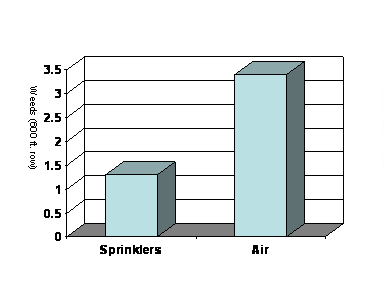
In this test: There were few weeds in this 36 acre block and it appeared as if both the aerial and sprinkler applied Kerb was effective. Weed counts indicated that the aerial applied 18 acres had slightly more needleleaf goosefoot that escaped treatment than the sprinkler applied 18 acres. Crop injury in the form of marginal chlorosis and leaf burn was present in both halves of this field and was thought to be the result of cold temperatures rather than the herbicide.
Test 2
Location: Tacna (41E and County 5th Street)
Grower/PCA: Amigo Farms/Jeff Nigh
Plot size: 11 acres
Date applied: 12-31-03
Days after sprinklers started: 5
Rate: 1.3 lb./ac
Evaluated: 1-30-04
Weeds: Shepardspurse and Sudangrass
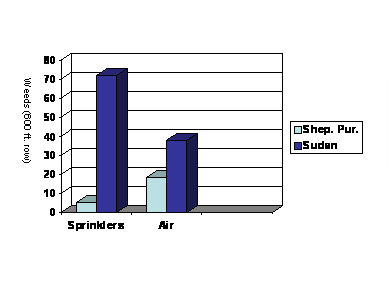
In this test: Shepardspurse control was significantly
better in the sprinkler applied section of this block than it was on the
aerial applied section. Sudangrass control, however, was poor in both
the sprinkler and aerial applied sections. There was more Sudangrass in
the sprinkler applied section than in the aerial applied section. There
may have been a greater infestation in this section than in the aerial
applied section but control of this weed was poor in both.
Test 3
Location; Yuma Valley (13th St & Avenue B)
Grower/PCA: Curry Farms/Bill Fox
Plot Size: 17 acres
Date Applied: 10-20-02
Days after sprinklers started: 3
Rate: 1.3 lb./ac
Evaluated: 11-19-02
Weeds: Shepardspurse
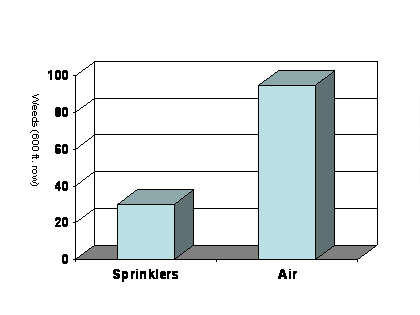
In this test: There was a high infestation of shepardspurse
in this block. Control was significantly better in the sprinkler applied
half than in the aerial applied half.
Test 4
Location: Yuma Valley (Ave H and Co 15th St)
Grower/PCA: Amigo Farms/Jeff Nigh
Plot Size: 13 acres
Date applied: 6-5-02
Days after sprinklers started: 1
Rate: 1.5 lb./ac
Evaluated: 6-25-02
Weeds: Common Purslane, Wright Groundcherry
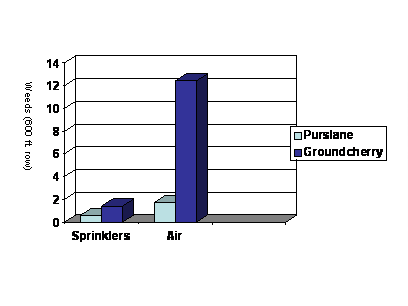
In this test: This test was conducted in mid-summer to compare aerial and sprinkler applied Kerb applications. This test was conducted 3 months before lettuce was planted and was not intended to represent a typical Kerb application. Weed counts indicated that the sprinkler application was significantly more effective in controlling both Groundcherry and Purslane than the aerial application.
Test 5
Location: Yuma Valley (Ave C and Co. 12th Street)
Grower/PCA: E. Harrison/Bill Fox
Plot Size: 17 acres
Date applied: 12-4-03
Days after sprinklers started: 3
Rate: 1.7 lb./ac
Evaluated: 1-6-04
Weeds: Shepardspurse
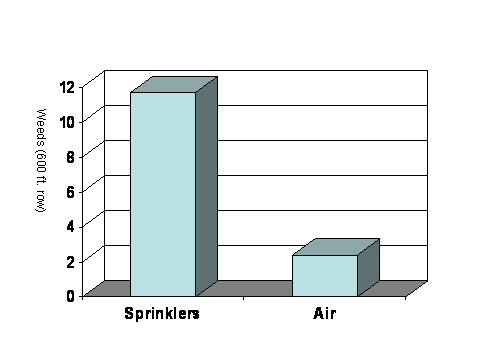
In this test: This test was not an equal comparison between aerial and sprinkler applications of Kerb but is included here because it demonstrates the importance of proper water management when making delayed applications of Kerb to minimize leaching of the herbicide. Our intention was to treat half of this 34 acre block with 1.7 lb./ac Kerb applied by air and half with 1.7 lb./ac Kerb applied through the sprinklers. The entire 34 acre block was mistakenly treated by air with 1.7 lb./ac. causing in the sprinkler applied half to receive two applications totaling 3.4 lb./ac. To minimize crop injury, the sprinklers were run an additional 24 hours on this half of the block. No crop injury occurred due to the leaching of the herbicide but weed control was also reduced significantly compared to the half of the field that did not receive the additional water.
Discussion
Broadleaf weed control was better in all tests from the sprinkler applied
Kerb than from the aerial applications. Test 5 was not an equal comparison
of the two application techniques because of the extra water applied to
the sprinkler applied section of this field. Sudangrass control was poor
in Test 2 and worse in the sprinkler applied section. The reason for this
is unclear. Crop injury occurred only in Test 1 and this was thought to
be from cold temperatures rather than from the herbicide. It was equally
present in both the aerial and sprinkler applied sections of the field.
It can be concluded from these tests that applying Kerb through sprinklers
to lettuce is effective and often superior to aerial applications. Proper
timing and water management are necessary for the success of both aerial
and sprinkler applications.
Issued in furtherance of Cooperative Extension work, acts of May 8 and June 30, 1914, in cooperation with the U.S. Department of Agriculture, James A. Christenson, Director Cooperative Extension, College of Agriculture and Life Sciences, The University of Arizona.
The University of Arizona is an equal opportunity, affirmative action institution. The University does not discriminate on the basis of race, color, religion, sex, national origin, age, disability, veteran status, or sexual orientation in its programs and activities.
Any products, services, or organizations that are
mentioned, shown, or indirectly implied in this web document do not imply
endorsement by The University of Arizona.
Information provided by:
Barry Tickes, btickes@ag.arizona.edu Extension Agent, Yuma County
University of Arizona, Tucson, Arizona.
Material written February 2004.
For more Arizona Production Ag Information:
Home | Cotton | Veggies| Forages | Grains | Citrus | Crop x Crop | Insects | Diseases| Weeds | Pesticides | News | Weather | Research | Photos | Contacts | General Info. | Site Map
document located at: http://cals.arizona.edu/crops/counties/yuma/farmnotes/2004/fn0204kerb.html
Copyright © 2001 University of Arizona,
College of Agriculture and Life Sciences
Webmaster: Al Fournier (fournier@ag.arizona.edu)